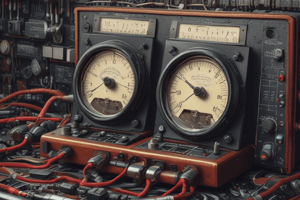Podcast
Questions and Answers
What is the function of the sensor in an electronic galvanometer?
What is the function of the sensor in an electronic galvanometer?
- Converts the amplified signal into a visual representation
- Provides temperature compensation features
- Boosts the weak signal produced by the sensor
- Detects changes in current flow (correct)
Which component of an electronic galvanometer is responsible for converting the weak signal into a stronger one?
Which component of an electronic galvanometer is responsible for converting the weak signal into a stronger one?
- Temperature compensation feature
- Display Unit
- Amplifier (correct)
- Sensor
In what field do galvanometers help maintain quality control standards?
In what field do galvanometers help maintain quality control standards?
- Educational Institutions
- Quality Assurance (correct)
- Research
- Calibration
Which application involves using galvanometers to teach students about electric circuits?
Which application involves using galvanometers to teach students about electric circuits?
What distinguishes electronic galvanometers from mechanical galvanometers?
What distinguishes electronic galvanometers from mechanical galvanometers?
Which component of an electronic galvanometer converts the amplified signal into a visual representation of current flow?
Which component of an electronic galvanometer converts the amplified signal into a visual representation of current flow?
What is the purpose of a galvanometer?
What is the purpose of a galvanometer?
How do mechanical galvanometers work?
How do mechanical galvanometers work?
What is the function of the pointer in a mechanical galvanometer?
What is the function of the pointer in a mechanical galvanometer?
Which component of a mechanical galvanometer is responsible for producing a strong magnetic field?
Which component of a mechanical galvanometer is responsible for producing a strong magnetic field?
What is the main difference between mechanical and electronic galvanometers?
What is the main difference between mechanical and electronic galvanometers?
What purpose does the scale serve in a mechanical galvanometer?
What purpose does the scale serve in a mechanical galvanometer?
Study Notes
Galvanometer
A galvanometer is an instrument used to measure electric current in a circuit. It consists of a coil suspended over a magnet so that when current flows through it, the coil moves due to electromagnetic forces. There are two main types of galvanometers: mechanical and electronic.
Mechanical Galvanometer
Mechanical galvanometers were once widely used before the advent of electronic devices. They consist of a fine coil placed between the poles of a permanent magnet. When electrical current enters the coil, it deflects due to its magnetic fields, which can be measured by observing the displacement of a pointer connected to the coil. This type of galvanometer is still used today, although it has been largely replaced by more modern techniques.
Important Components of a Mechanical Galvanometer
- Coil: A thin wire wound onto a hollow metal cylinder on either end.
- Magnet: A strong magnetic field produced by a horseshoe magnet with one pole located close to the coil and the other some distance away.
- Pointer: A lightweight rod attached to the coil so that any displacement of the latter would cause the former to move along with it.
- Scale: An evenly graduated scale placed near the pointer to indicate the amount of deflection caused by the current.
Electronic Galvanometer
Modern electronic galvanometers work by detecting changes in current flow and converting these into a signal that can be displayed visually. These instruments usually have a digital display and no moving parts, making them more reliable and precise compared to their mechanical counterparts. Additionally, electronic galvanometers often come with built-in temperature compensation features to further improve accuracy.
Important Components of an Electronic Galvanometer
- Sensor: A device that detects changes in current flow, such as a Hall effect sensor or a current transformer.
- Amplifier: An electronic component that boosts the weak signal produced by the sensor into a stronger one suitable for further processing.
- Display Unit: The part of the instrument that converts the amplified signal into a visual representation of the current flow.
Applications of Galvanometers
Galvanometers find applications in various fields, including:
- Quality Assurance: In this context, galvanometers help maintain quality control standards by ensuring products meet required specifications.
- Research: Scientists often use galvanometers during experiments related to electrical current research.
- Calibration: They are used to calibrate other measuring devices like ammeters and multimeters.
- Educational Institutions: Galvanometers serve as essential tools for teaching students about electric circuits and current measurement.
Studying That Suits You
Use AI to generate personalized quizzes and flashcards to suit your learning preferences.
Description
Explore the differences between mechanical and electronic galvanometers, their key components, and applications. Learn about the functions of a coil, magnet, pointer, scale in a mechanical galvanometer and the sensor, amplifier, and display unit in an electronic galvanometer. Discover how galvanometers are used in quality assurance, research, calibration, and educational institutions.




